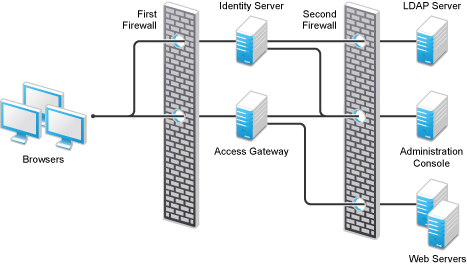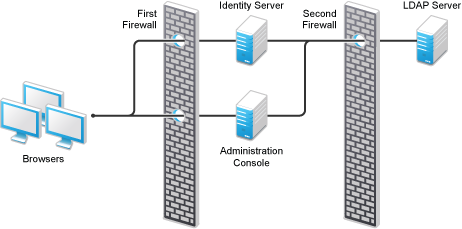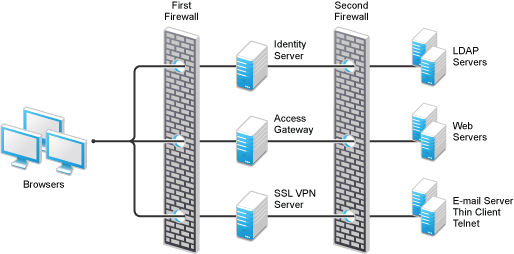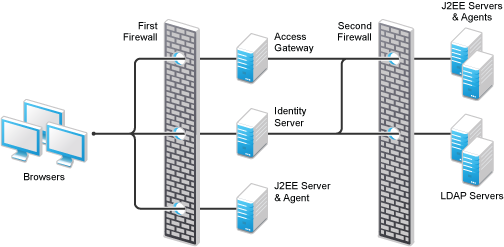4.2 Sample Configurations
4.2.1 The Access Gateway and Identity Server in the DMZ
Figure 4-2 The Identity Server and the Access Gateway in the DMZ

First Firewall
If you place a firewall between the browsers and the Access Gateway and Identity Server, you need to open ports so that the browsers can communicate with the Access Gateway and the Identity Server and the Identity Server can communicate with other Identity Providers.
Table 4-8 Ports to Open in the First Firewall
|
Port |
Purpose |
|---|---|
|
TCP 80 |
For HTTP communication. |
|
TCP 443 |
For HTTPS communication. |
|
Any TCP port assigned to a reverse proxy or tunnel. |
|
|
TCP 8080 |
For HTTP communication with the Identity Server. For information about redirecting the Identity Server to use port 80, see |
|
TCP 8443 |
For HTTPS communication with the Identity Server. For information about redirecting the Identity Server to use port 443, see |
|
TCP 8445 |
For HTTP Identity Provider introductions. If you do not enable Identity Provider introductions, you do not need to open this port. For more information about this option, see the option in |
|
TCP 8446 |
For HTTPS Identity Provider introductions. If you do not enable Identity Provider introductions, you do not need to open this port. For more information about this option, see the option in |
Second Firewall
The second firewall separates the Web servers, LDAP servers, and the Administration Console from the Identity Server and the Access Gateway. You need the following ports opened in the second firewall:
Table 4-9 Ports to Open in the Second Firewall
4.2.2 A Firewall Separating Access Manager Components from the LDAP Servers
You can configure your Access Manager components so that your Administration Console is on the same side of the firewall as your Access Manager components and have a firewall between them and the LDAP servers, as illustrated in Figure 4-3.
Figure 4-3 A Firewall Separating the Administration Console and the LDAP Server

In this configuration, you need to have the following ports opened in the second firewall for the Administration Console and the Identity Server.
Table 4-10 Ports to Open in the Second Firewall
4.2.3 Configuring the Firewall for the SSL VPN Server
The SSL VPN server can be installed as a separate machine or as a component running on the Linux Access Gateway. Although it is configured to be a protected resource of the Access Gateway, it also allows direct communication with the client browsers.
Figure 4-4 SSL VPN Server and Firewalls

The SSL VPN server needs the following port opened on the first firewall if clients are accessing the SSL VPN server directly:
Table 4-11 Ports to Open in the First Firewall for SSL VPN
|
Port |
Purpose |
|---|---|
|
TCP 7777 |
For client communication. This is the default port, but it can be configured to use TCP 443. |
You need to open ports on the second firewall according to the offered services.
4.2.4 Configuring the Firewall for the J2EE Agent
The J2EE Agent is installed on a J2EE server running JBoss, WebLogic, or WebSphere. You can configure it to be a protected resource of the Access Gateway or you can allow direct access. Figure 4-5 illustrates these configurations.
Figure 4-5 J2EE Agent and Firewalls

If the J2EE server is installed behind the first firewall and browsers are allowed direct access to it, the following ports need to be opened in the first firewall:
Table 4-13 Ports to Open in the First Firewall for the J2EE Agent
If the J2EE server is installed behind the second firewall, the following ports need to be opened in the second firewall:
Table 4-14 Ports to Open in the Second Firewall for the J2EE Agent